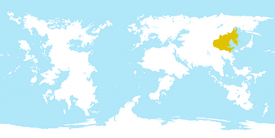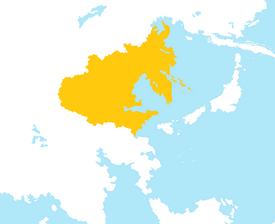Oya'in
Greater Eastern Union of Zhenia 대동진국연방 大東秦國聯邦 | |
|---|---|
| Motto: "자유, 민권, 민생." Liberty, Democracy and the Welfare of the People. | |
| Anthem: Spirit of Zhenia | |
 Location of Zhenia in the world in gold. | |
 A map of Zhenia in Northeast Tarsis. | |
| Capital and largest city | Daedo |
| Official languages | Zhenian |
| Other languages | |
| Ethnic groups (2019) |
|
| Demonym(s) | Zhenian |
| Government | Federal Semi-Presidential Republic |
| Lee Saemin | |
• Premier | Kim Junghun |
| Legislature | Parliament of the Greater Eastern Union |
| Sangseowon | |
| Federal Assembly | |
| Establishment | |
• as the Shindan dynasty | July 3, 1298 |
• as the Empire of Greater Wu | January 5, 1567 |
• as the Empire of Zhenia | August 3, 1868 |
| June 4, 1909 | |
• as current form | December 1, 1979 |
| Area | |
• | 6,391,077.1 km2 (2,467,608.7 sq mi) |
• Water (%) | 3.39% |
| Population | |
• 2020 estimate | 599.6 million |
• 2020 census | 599,711,689 |
• Density | 93.7/km2 (242.7/sq mi) |
| GDP (PPP) | 2019 estimate |
• Total | $16.372 trillion |
• Per capita | $27,300.24 |
| GDP (nominal) | 2019 estimate |
• Total | $15.161 trillion |
• Per capita | $25,281.3 |
| Gini (2019) | medium |
| HDI (2017) | very high |
| Currency | Zhenian Won (ZKW) |
| Time zone | UTC+7, +8 (ZWST, ZEST) |
| Date format | dd-mm-yyyy |
| Driving side | right |
| Calling code | +11 |
| Internet TLD | .zh/.zhen/.geu |
Zhenia (Classic Zhenian: 秦國, Modern Zhenian: 진국), formally known as the Greater Eastern Union of Zhenia (Classic Zhenian: 大東秦國聯邦, Modern Zhenian: 대동진국연방), is a federal semi-presidential republic consisting of 28 provinces, 5 metropolitan municipalities and one special city. Situated in East Tarsis and spanning across 6,391,077.1 km2 over both mainland Zhenia and the Danguk Peninsula, it is the second-largest in the world by territorial size after Florencia. It borders Yinguo directly to its south and by numerous entities in the region in other directions. Situated on the eastern seaboard of the continent, the nation faces the North Zhenian Sea and East Zhenian Sea to its northeast and east, as well as the Gulf of Danguk.
Civilization emerged in both mainland Zhenia and the Danguk Peninsula around 2,000 BCE. The Liang Dynasty came to existence in central Zhenia around 2300 BCE, while the State of Danguk was founded around 2000 BCE. Since then, much of Zhenian history consisted of hereditary monarchies, or dynasties, and their expansion, fracture and replacement by other entities. In 322 BCE, the Zhen dynasty, led by Shen Lien, became the first dynasty to unify both the Danguk Peninsula and mainland Zhenia, conquering most of East and Southeast Tarsis and expanding well beyond the Taimir Basin. The Zhen dynasty developed into one of the largest empires of the ancient world, being a leading political, cultural and religious center; it had also been the first entity to pass the legacy of Zhenian culture, having assimilated mainland Zhenian cultural elements into those of the Danguk Peninsula as well as creating the notion of a unified entity in Zhenia for the first time in its history.
Following the demise of the Zhen dynasty, mainland Zhenia was ruled by numerous smaller entities during an era known as the Hundred States Era and ravaged by political unrest and invasions from northern nomadic tribes, the Danguk Peninsula enjoyed relative stability under the rule of the Eastern Zhen and later the Daehwa dynasty. Mainland Zhenia was temporarily unified by the Jin in the 9th century, which rebuilt Zhenian trade routes connecting to the western world; this too would end with the Second Hundred States Era and the Kharlin invasions in the 12th century, during which the mainland was left vulnerable to foreign domination and exploitation. Although the Zhu and Shindan dynasties prevailed in the mainland and the Danguk Peninsula respectively after the Kharlins were driven out, Zhenia remained divided between two entities that walked separate paths, while the Shindan became a tributary state of the Greater Wu in the mid-17th century.
In the early 19th century, Greater Wu opened ports and submitted to Auroran extraterritoriality in its territory following a series of military defeats; this sparked calls for strenuous efforts for Zhenian sovereignty against the mainland from the Danguk Peninsula, as well as political upheaval. Emperor Seongjo, having transformed the nation from a backwater tributary state to an industrialized regional power, unified the centuries-divided nation into the Empire of Zhenia following the Zhenian Civil War. Zhenia's resurgence in the 19th century saw the rise of the Shinzhen Movement, resulting in military conflicts against Auroran colonial powers within Zhenia's sphere of influence. Although its victory in the First Great War confirmed its status as a global, expansionist military power. Zhenian involvement in the Second Great War ended in its defeat in 1948. In 1955, a military junta headed by Kim Shimin was established, with the newly-established regime propelling the nation's rapid economic recovery after the Second Great War. The November Revolution of 1979 brought an end to the Third Republic and resulted in the democratization of Zhenia, as well as the Fourth Republic that exists to this day.
Today, Zhenia is regarded as one of the world's most culturally and economically advanced nations as a developed nation; with a GDP purchasing power parity (PPP) at $16.37 trillion, it is home to one of the largest single economies in the world, while it is one of the largest exporters and importers of goods in the world. It is a global leader in an array of industrial and technological sectors, with its export-driven economy leading the world on electronics, aerospace, automobiles, shipbuilding and robotics. It has one of the largest defense budgets in the world at around $651 billion and has been a nuclear weapons state since 1959. Amid its rise in political and economic power, Zhenia has been characterized as a global great power, with speculations that it will achieve superpower status by 2030.


